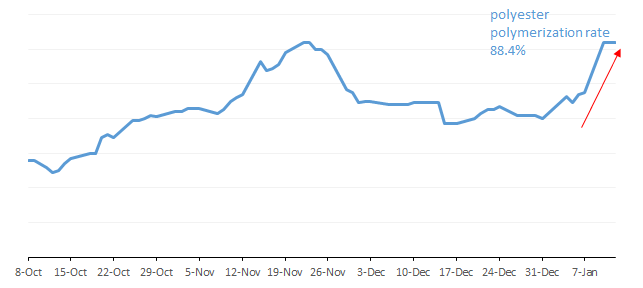Why polyester polymerization rate going up regardless of the seasonal factor ?
The polyester polymerization rate rose unexpectedly from the beginning of this year.
Some orders have been placed in local markets like Nantong and Guangdong as the weather turned colder. Additionally, the export orders increased again recently. Some fabric mills and dyeing mills have to postpone the holiday one week to ten days later in order to fulfill the orders to be delivered before Spring Festival. Thus, the operating rate of fabric mills slides more slowly than expected.
According to CCFGroup's survey, some small and medium-sized polyester enterprises plan to just cut production instead of shutdown for maintenance, and the production reduction is concentrated in mid-to late Jan. On the other hand, some large filament yarn plants raise operating rate, so the polyester polymerization rate improves from 85.3% in early Jan to current 88.4% with an increase of 3.1 percentage points.

In addition, as some polyester plants have completed maintenance earlier, and the pandemic spreading regionally may bring risks that staffs may not be able to return to work after Spring Festival holiday, some polyester companies decide to cut production partially rather than shutting the whole plant for maintenance.
The dual controls in energy consumption and intensity are expected to continue in 2022, and adding to that is the Asian Games to be held in Hangzhou, Zhejiang in Sep. It is very likely that polyester plants would have to cut production due to policy requirements. Therefore, in the beginning of 2022 and during the Spring Festival holiday, when the dual controls have been lifted, polyester plants would cut production as little as possible.
As a result, polyester plant operating rate rose counter-seasonally in the first half of Jan, as large PFY plants raised operating rate. However, the operating rate may decline gradually in the latter half month, with polyester plants going to cut production prior to the Spring Festival stating from end-Jan. The monthly average operating rate is estimated to be around 86% in Jan, up from previous expectation of 84% and above the level in the same period of last years. However, as downstream plants would generally shut earlier, especially for warp knitting plants, PFY inventory could be high after the holiday, and even above the level seen in the same period of last years. Whether the high inventory would lead to lower price and whether the inventory could be reduced will be dependent on crude oil and end-use demand after the holiday.
- Top keywords
- Cotton Price
- Cotton Futures Price
- Cotton Futures
- CZCE
- PTA Futures Price
- Chemical Fiber
- Polyester Prices
- Wool price
- PTA Futures
- Shengze Silk
- China
- Yarn Price
- price
- China Textile City
- Fibre Price
- Benzene Price
- Cotton
- Index
- Cotton Index
- PTA
- fabric price
- NYMEX
- Top 10
- textile industry
- Spot Cotton
- Cotton Yarn
- Polyester Price
- Futures
- PTA Price
- cotton yarn price

